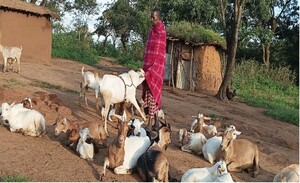
Markhor-derived introgression of PAPSS2 confers high-altitude adaptability in Tibetan goats
Abstract
Understanding the genetic mechanism of how animals adapt to extreme environments is fundamental to unriddle the relationship between molecular evolution and continuous climate change. After domestication, goats have developed strong adaptation to various environments, including harsh conditions at high-altitudes with low temperature and reduced oxygen concentrations. Here, we utilized 331 genomes of goats living at varying altitudes (high >3,000 m above sea level and low <1,200 m) as well as wild caprid species to precisely dissect genetic determinants underlying the adaptation to high altitudes on the Qinghai-Tibetan Plateau (QTP). Population genomic analyses combined with genome-wide association testing revealed that the PAPSS2 locus confers adaptability to high altitudes in Tibetan goats. Additionally, this gene harbours significant signatures of interspecies introgression from a wild caprid species, markhor (Capra falconeri). We further demonstrated a functional role for PAPSS2 in response to hypoxia using PAPSS2-deficient cells. In conclusion, our results suggest a hitherto unknown contribution of PAPSS2 to high-altitude adaptation and showed that interspecific introgression contributed to the adaptation of goats to the harsh conditions at the Tibetan Plateau.
Citation
Li, C., Wu, Y., Chen, B., Cai, Y., Guo, J., Kalds, P., Chen, Y., Pausch, H., Han Jianlin, Jiang, Y., and Wang, X. 2023. Markhor-derived introgression of PAPSS2 confers high-altitude adaptability in Tibetan goats. IN: Veerkamp, R.F. and Y. de Haas. 2023. Proceedings of the World Congress on Genetics Applied to Livestock Production (WCGALP), Rotterdam, the Netherlands, 3-8 July 2022. Wageningen: Wageningen Academic Publishers: 802-805










